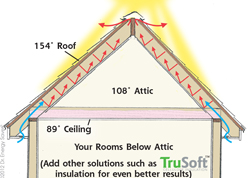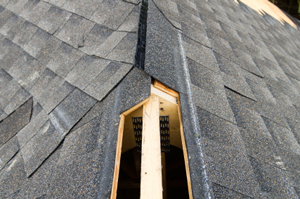In Business Since | License #
In Business Since | License #


A radiant barrier, installed on the underside of rafters, reflects heat energy back toward the roof. Ridge vents and soffit vents allow a convection air flow that expels the hot air.
Roof ventilation plays an important role in keeping a house cool during hot weather. With proper roof ventilation, hot air that builds up beneath the roof sheathing can escape through ridge and gable vents.
As hot air escapes, driven by convection, an equal volume of cooler air is drawn into soffit vents located at the eaves of the house. The result is a cooler attic -- and a cooler attic translates into cooler rooms in the living space below.
To see if your roof ventilation is working as it should be, invite your local Dr. Energy Saver to perform a home energy audit, or get a free quote on just the ventilation! Our certified dealers are dedicated to helping homeowners achieve energy savings throughout their homes.
"Passive" roof ventilation (as opposed to "active" ventilation with electrically powered vent fans) is accomplished using a combination of soffit, ridge and gable-end vents. Roofing contractors and home energy analysts can calculate a roof's ventilation requirements based on the size of house.
The total square inches of ventilation area is usually divided equally between soffit vents and ridge vents or between soffit vents and a combination of ridge and gable-end vents.

Vent space at the ridge of this asphalt roof allows super heated air to escape during the summer. In winter, it allows cold air into the air, necessitating adequate insulation at the rafters or the attic floor.
Providing adequate roof ventilation isn't the only way to reduce your cooling costs on hot summer days. It's important to insulate your attic or attic roof to levels recommended by the Dept. of Energy. (See Related pages, below.) With effective attic insulation, your home will retain valuable heat during winter months and slow heat transfer to the interior during the cooling season.
Installing a radiant barrier in the attic will also save energy by reflecting solar heat back toward the exterior. A radiant barrier works just like the shiny reflective heat shields that many people place in car windshields to protect the car interior from excessive solar heat gain.
Ready to have your roof ventilation inspected, along with attic roof insulation and other energy performance enhancements tackled? Dr. Energy Saver has the experience and expertise needed to provide lasting energy efficiency in your home. Contact your local dealer to get started on roof ventilation needs today!
Looking for a price? Get a no cost, no obligation free estimate.